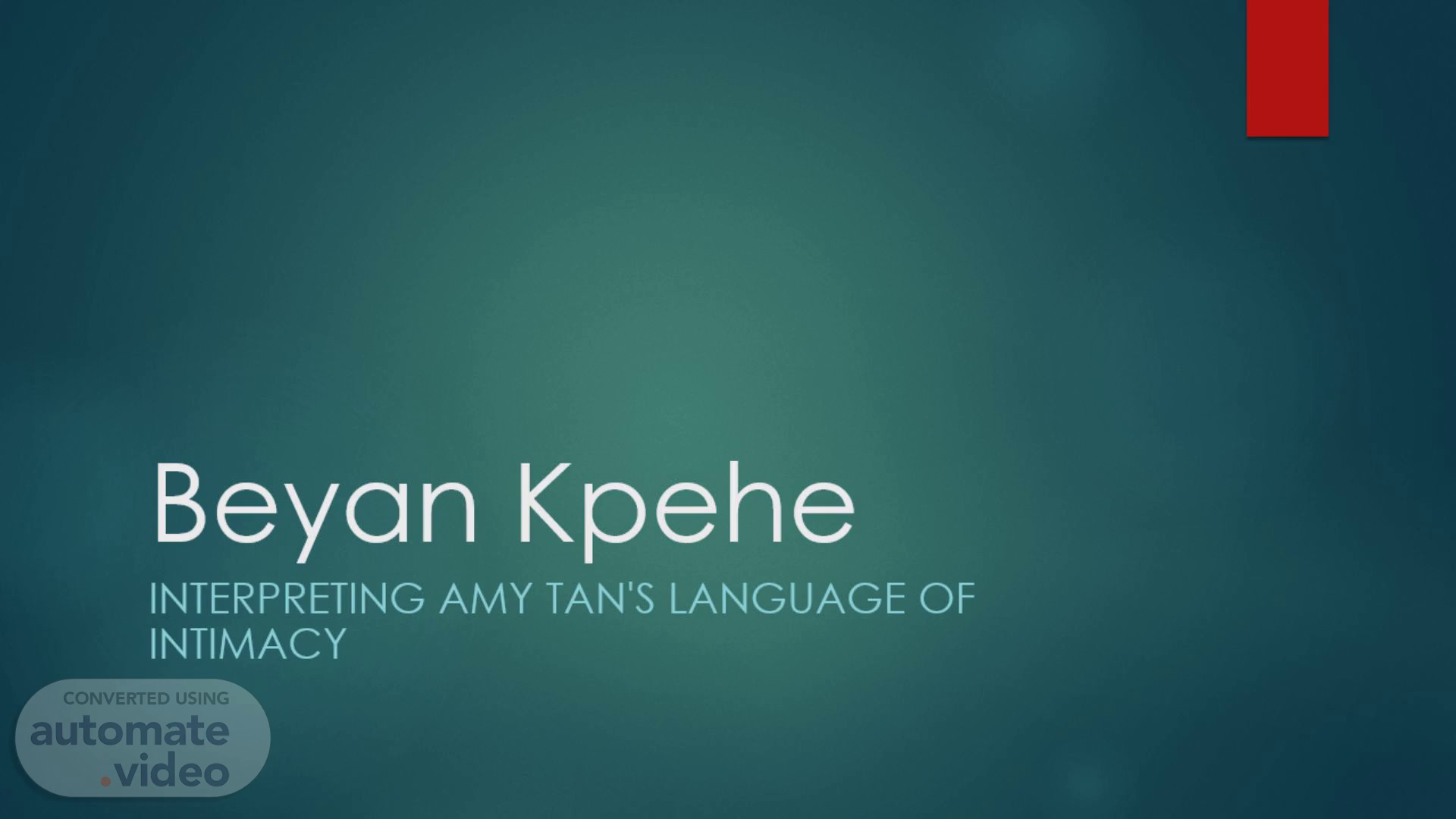
Beyan Kpehe
Scene 1 (0s)
[Audio] Beyan Kpehe Interpreting Amy Tan's Language of Intimacy.
Scene 2 (7s)
[Audio] Introduction Language of intimacy: Amy Tan's concept of unique and personal communication style with close relationships. Amy Tan: Famous American writer of Chinese descent who explores identity, culture, and family in her novels and essays. Main argument: Language of intimacy creates and reflects connection, identity, and trust, and varies by context and factors. Language of intimacy: Amy Tan's concept of unique and personal communication style with close relationships. Amy Tan: Famous American writer of Chinese descent who explores identity, culture, and family in her novels and essays. Main argument: Language of intimacy creates and reflects connection, identity, and trust, and varies by context and factors..
Scene 3 (1m 8s)
[Audio] How the language of intimacy works Definition and examples: Language that allows free and authentic expression without fear of judgment or misunderstanding (e.g., Tan's "mother tongue"). Connection and understanding: Language that is based on shared experiences, inside jokes, and trust (e.g., Tan's bond with her mother). Evolution and change: Language that grows and changes over time as individuals learn from each other (e.g., Tan's influence on her husband's English). Definition and examples: Language that allows free and authentic expression without fear of judgment or misunderstanding (e.g., Tan's "mother tongue"). Connection and understanding: Language that is based on shared experiences, inside jokes, and trust (e.g., Tan's bond with her mother). Evolution and change: Language that grows and changes over time as individuals learn from each other (e.g., Tan's influence on her husband's English)..
Scene 4 (2m 20s)
[Audio] Why language of intimacy is important Genuine and personal communication: Language that reflects thoughts, feelings, and personality, and conveys identity and values (e.g., Tan's mother's vivid and direct English). Bonding and strengthening: Language that creates closeness and shared identity, and fosters respect and appreciation (e.g., Tan's success as a writer and her mother's verdict). Non-verbal communication: Language that can be expressed through shared looks, gestures, or physical contact (e.g., Tan's communication with her mother through eye contact and facial expressions). Genuine and personal communication: Language that reflects thoughts, feelings, and personality, and conveys identity and values (e.g., Tan's mother's vivid and direct English). Bonding and strengthening: Language that creates closeness and shared identity, and fosters respect and appreciation (e.g., Tan's success as a writer and her mother's verdict). Non-verbal communication: Language that can be expressed through shared looks, gestures, or physical contact (e.g., Tan's communication with her mother through eye contact and facial expressions)..
Scene 5 (3m 44s)
[Audio] How language of intimacy is used in different contexts Type and closeness of relationship: Language that varies by frequency, intensity, and formality (e.g., language of intimacy between romantic partners, siblings, friends, or colleagues). Protection and privacy: Language that allows sharing personal and private information, and creates security and confidentiality (e.g., language of intimacy to cope with stress, trauma, or conflict). Culture, identity, and power: Language that is influenced by cultural norms, values, and beliefs, and by identity and self-image, and by power dynamics and inequalities (e.g., language of intimacy and its relation to dominant culture, language ability, and social status). Type and closeness of relationship: Language that varies by frequency, intensity, and formality (e.g., language of intimacy between romantic partners, siblings, friends, or colleagues). Protection and privacy: Language that allows sharing personal and private information, and creates security and confidentiality (e.g., language of intimacy to cope with stress, trauma, or conflict). Culture, identity, and power: Language that is influenced by cultural norms, values, and beliefs, and by identity and self-image, and by power dynamics and inequalities (e.g., language of intimacy and its relation to dominant culture, language ability, and social status)..
Scene 6 (5m 26s)
[Audio] Conclusion Summary: Language of intimacy is a unique and personal communication style that creates and reflects connection, identity, and trust, and that varies by context and factors Implications and recommendations: Be aware, respectful, and appreciative of the language of intimacy in close relationships, and overcome any barriers or challenges to communication and understanding Summary: Language of intimacy is a unique and personal communication style that creates and reflects connection, identity, and trust, and that varies by context and factors Implications and recommendations: Be aware, respectful, and appreciative of the language of intimacy in close relationships, and overcome any barriers or challenges to communication and understanding.
Scene 7 (6m 20s)
[Audio] Q&A How does the language of intimacy change over time and across stages, cultures, and languages? How does it affect mental health and well-being? How can it be taught and learned? How can it be used to enhance communication and relationships in different settings? How does the language of intimacy change over time and across stages, cultures, and languages? How does it affect mental health and well-being? How can it be taught and learned? How can it be used to enhance communication and relationships in different settings?.